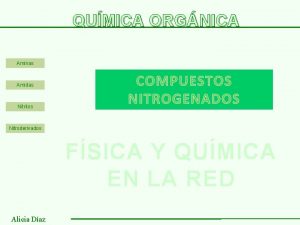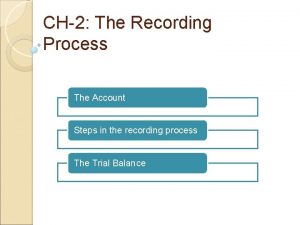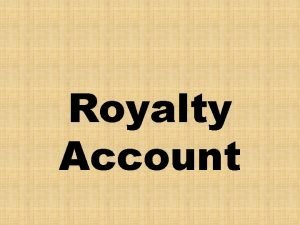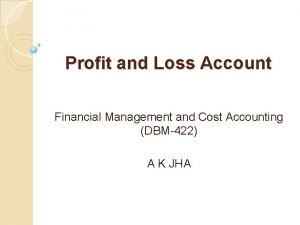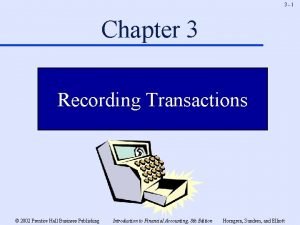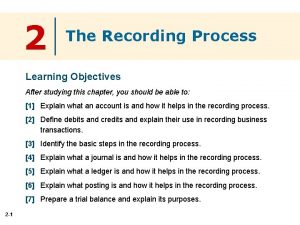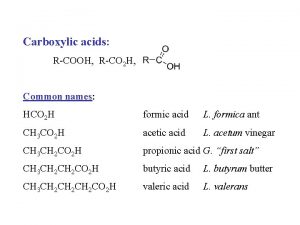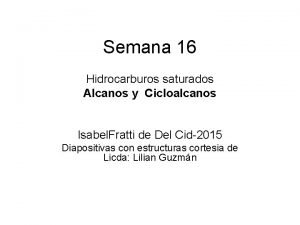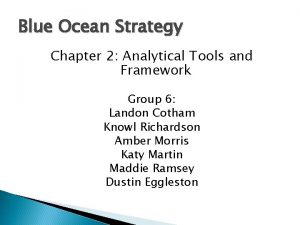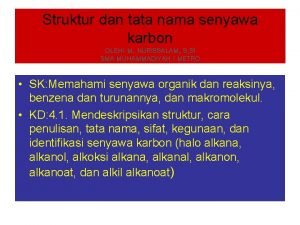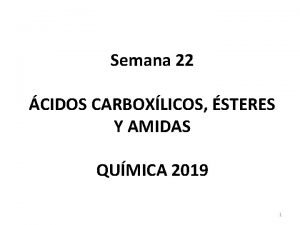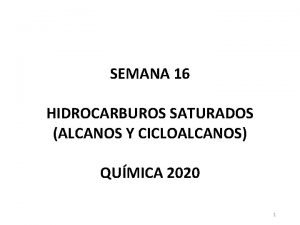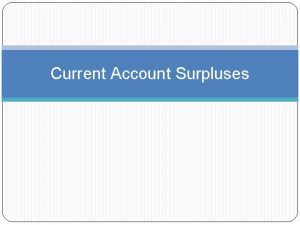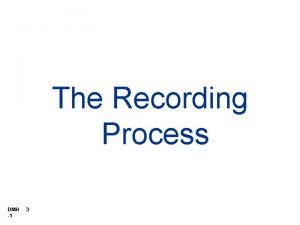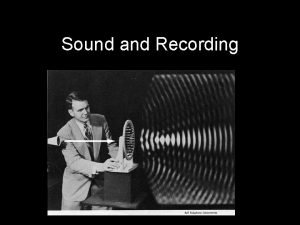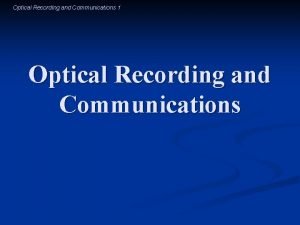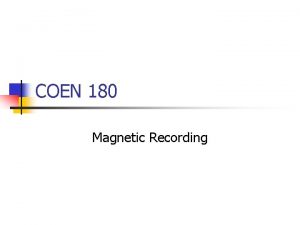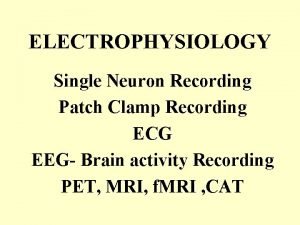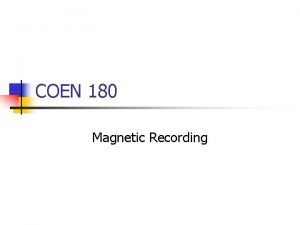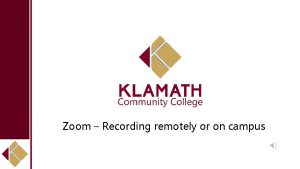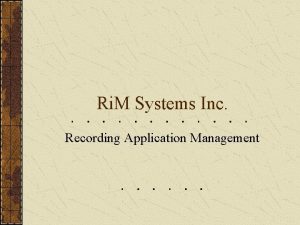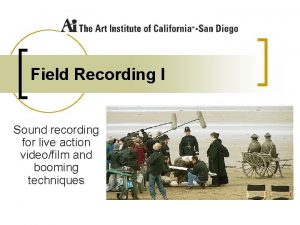CH2 The Recording Process The Account Steps in



































- Slides: 35

CH-2: The Recording Process The Account Steps in the recording process The Trial Balance

Study Objectives 1. Explain what an account is and how it helps in the recording process. 2. Define debits and credits and explain their use in recording business transactions. 3. Identify the basic steps in the recording process. 4. Explain what a journal is and how it helps in the recording process. 5. Explain what a ledger is and how it helps in the recording process. 6. Explain what posting is and how it helps in the recording process. 7. Prepare a trial balance and explain its purposes.

The Recording Process The Account Debits and credits Expansion of basic equation Steps in the Recording Process Journal Ledger The Recording Process Illustrated Summary illustration of journalizing and posting The Trial Balance Limitations of a trial balance Locating errors Use of dollar signs

The Account An account is an accounting record of increase and decrease in a specific asset, liability, or owner’s equity item. Debit = “Left” Credit = “Right” An Account can be illustrated in a TAccount form.

The Account Debit and Credit Procedures Double-entry system ► Each transaction must affect two or more accounts to keep the basic accounting equation in balance. ► Recording done by debiting at least one account and crediting another. ► DEBITS must equal CREDITS.

Debits and Credits If Debits are greater than Credits, the account will have a debit balance. Transaction #1 $10, 000 Transaction #3 8, 000 Balance $15, 000 $3, 000 Transaction #2

Debits and Credits If Credits are greater than Debits, the account will have a credit balance. Transaction #1 Balance $10, 000 $3, 000 Transaction #2 8, 000 Transaction #3 $1, 000

The Account u Increase in Assets are recorded as Debit u Increase in Liabilities are recorded as Credit. u Normal balance is on the increase side.

The Account u Increase in Owner’s Equity are recorded as Credit u Remember: o Investment (Capital) and Revenue increases onwer’s equity o Drawings and Expenses decrease owner’s equity

The Account

Debits and Credits Summary Normal Balance Debit Normal Balance Credit

The Account Summary of Debit/Credit Rule Relationship among the assets, liabilities and owner’s equity of a business: Basic Equation Assets = Liabilities + Owner’s Equity Expanded Basic Equation The equation must be in balance after every transaction. For every Debit there must be a Credit.

Debits and Credits Summary Balance Sheet Asset Debit Credit = Liability Income Statement + Equity Revenue - Expense

Debits and Credits Summary Review Question Debits: a. increase both assets and liabilities. b. decrease both assets and liabilities. c. increase assets and decrease liabilities. d. decrease assets and increase liabilities.

Debits and Credits Summary Review Question Accounts that normally have debit balances are: a. assets, expenses, and revenues. b. assets, expenses, and owner’s capital. c. assets, liabilities, and owner’s drawings. d. assets, owner’s drawings, and expenses.

Steps in the recording process Analyze each transaction Enter transaction in a journal Transfer journal information to ledger accounts Source documents, such as a sales slip, a check, a bill, or a cash register tape, provide evidence of the transaction. )

Steps in the recording process The Journal u Book of original entry. u Transactions recorded in chronological order. u Contributions to the recording process: 1. Discloses the complete effects of a transaction. 2. Provides a chronological record of transactions. 3. Helps to prevent or locate errors because the debit and credit amounts can be easily compared.

Steps in the recording process Journalizing - Entering transaction data in the journal. Example: On September 1, Ray Neal invested $15, 000 cash in the business, and Softbyte purchased computer equipment for $7, 000 cash. General Journal Sept. 1 Cash 15, 000 Owner’s, Capital Equipment Cash 15, 000 7, 000

Journalizing E 2 -4 (Facts) Presented below is information related to Hanshew Real Estate Agency. Oct. 1 Pete Hanshew begins business as a real estate agent with a cash investment of $15, 000. General Journal

Journalizing E 2 -4 (Facts) Presented below is information related to Hanshew Real Estate Agency. Oct. 3 Purchases office furniture for $1, 900, on account. General Journal

Journalizing E 2 -4 (Facts) Presented below is information related to Hanshew Real Estate Agency. Oct. 6 Sells a house and lot for B. Kidman; bills B. Kidman $3, 200 for realty services provided. General Journal

Journalizing E 2 -4 (Facts) Presented below is information related to Hanshew Real Estate Agency. Oct. 27 Pays $700 on balance related to transaction of Oct. 3. General Journal

Journalizing E 2 -4 (Facts) Presented below is information related to Hanshew Real Estate Agency. Oct. 30 Pays the administrative assistant $2, 500 salary for Oct. General Journal

Journalizing Simple Entry – Two accounts, one debit and one credit. Compound Entry – Three or more accounts. Example – On June 15, H. Burns, purchased equipment for $15, 000 by paying cash of $10, 000 and the balance on account (to be paid within 30 days). General Journal

Steps in the recording process The Ledger u General Ledger contains the entire group of accounts maintained by a company. u The General Ledger includes all the asset, liability, owner’s equity, revenue and expense accounts.

Steps in the recording process Example: Standard Form of Account

Chart of Accounts and account numbers arranged in sequence in which they are presented in the financial statements.

Standard Form of Account T-account form used in accounting textbooks. In practice, the account forms used in ledgers are much more structured.

Posting – the process of transferring amounts from the journal to the ledger accounts. General Journal J 1 101 General Ledger Oct. 1 J 1 15, 000

Posting Review Question Posting: a. normally occurs before journalizing. b. transfers ledger transaction data to the journal. c. is an optional step in the recording process. d. transfers journal entries to ledger accounts.

Steps in the recording process Posting – process of transferring amounts from the journal to the ledger accounts.

The Recording Process Illustrated Follow these steps: 1. Determine what type of account is involved. 2. Determine what items increased or decreased and by how much. 3. Translate the increases and decreases into debits and credits. Illustration 2 -19

The Trial Balance Example: A list of accounts and their balances at a given time. Purpose is to prove that debits equal credits.

The Trial Balance Limitations of a Trial Balance The trial balance may balance even when 1. a transaction is not journalized, 2. a correct journal entry is not posted, 3. a journal entry is posted twice, 4. incorrect accounts are used in journalizing or posting, or 5. offsetting errors are made in recording the amount of a transaction.

The Trial Balance Review Question A trial balance will not balance if: a. a correct journal entry is posted twice. b. the purchase of supplies on account is debited to Supplies and credited to Cash. c. a $100 cash drawing by the owner is debited to Owner’s Drawing for $1, 000 and credited to Cash for $100. d. a $450 payment on account is debited to Accounts Payable for $45 and credited to Cash for $45.
 Ch3 ch2 ch2 ch2 ch2 ch2 ch3
Ch3 ch2 ch2 ch2 ch2 ch2 ch3 Ch2=ch2+hcl→
Ch2=ch2+hcl→ Ch2=ch-ch2-ch3
Ch2=ch-ch2-ch3 Ch3-ch2-ch2-no2
Ch3-ch2-ch2-no2 Propanonitrilo grupo funcional
Propanonitrilo grupo funcional Account rule
Account rule The recording process illustrated
The recording process illustrated Steps in recording process
Steps in recording process Trade receivables in income statement
Trade receivables in income statement Royality account
Royality account Errors that affect the trial balance
Errors that affect the trial balance Explain profit and loss account
Explain profit and loss account First hand account and secondhand account
First hand account and secondhand account Recording process in accounting
Recording process in accounting Process recording example
Process recording example Recording process in accounting
Recording process in accounting Recording in accounting process
Recording in accounting process Summary recording
Summary recording Objectives of process recording
Objectives of process recording What is the common name for (ch3)2choch2(ch2)3ch3?
What is the common name for (ch3)2choch2(ch2)3ch3? Ch3-ch2-ch3 nome
Ch3-ch2-ch3 nome Rcooh to rconh2
Rcooh to rconh2 Ch3(ch2)9cch
Ch3(ch2)9cch Carboxylic esters
Carboxylic esters Ciclopropano + cl2
Ciclopropano + cl2 Ch3-(ch2)3-cho
Ch3-(ch2)3-cho Se
Se Southwest airlines
Southwest airlines 2-pentenonitrilo
2-pentenonitrilo Ch3-ch-ch-ch3
Ch3-ch-ch-ch3 R-c-h=o
R-c-h=o Butanamida estructura
Butanamida estructura Isopropilciclohexano
Isopropilciclohexano Qumica
Qumica Ch3och=ch2
Ch3och=ch2 Ch3och=ch2
Ch3och=ch2




